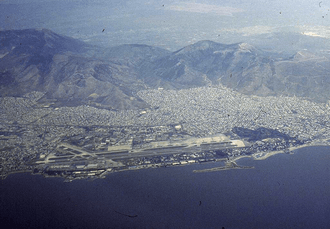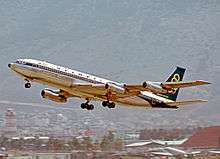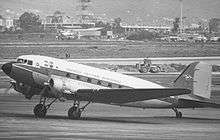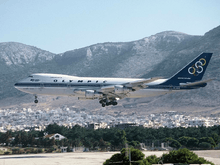Ellinikon International Airport
Ellinikon International Airport, sometimes spelled Hellinikon (Greek: Ελληνικόν) was the international airport of Athens, Greece for 63 years up until 28 March 2001, when it was replaced by the new Athens International Airport, Eleftherios Venizelos. The grounds of the airport are located 7 kilometres (4.3 mi) south of Athens, and just west of Glyfada. It was named after the village of Elliniko (Elleniko), now a suburb of Athens. The airport had an official capacity of 11 million passengers per year, but had served 13.5 million passengers during its last year of operations.
Hellinikon (or Ellinikon or Hellenikon) International Airport Διεθνής Αερολιμένας Ελληνικού | |||||||||||||||
|---|---|---|---|---|---|---|---|---|---|---|---|---|---|---|---|
 Aerial view of the airport. The construction site on the top of the image is what would become the new Athens airport | |||||||||||||||
| Summary | |||||||||||||||
| Airport type | Public | ||||||||||||||
| Owner | Hellinikon S.A.[2] | ||||||||||||||
| Location | Elliniko, Athens | ||||||||||||||
| Elevation AMSL | 21 m / 68 ft | ||||||||||||||
| Coordinates | 37°53′54″N 23°43′46″E | ||||||||||||||
| Website | www | ||||||||||||||
| Runways | |||||||||||||||
| |||||||||||||||
The airport is closed to all aviation. | |||||||||||||||
The former airport is now the site of a major development for coastal Athens, Hellenikon Metropolitan Park. Beginning in 2020 luxury homes, hotels, a casino, a marina, shops and offices are to be built there.[3][4]
History



The airport was built in 1938. Germans invaded Greece in 1941, and Kalamaki Airfield (as the site was then known) was used as a Luftwaffe air base during the occupation. After World War II, the Greek government allowed the United States to use the airport from 1945 until 1993. Known as Hassani Airport in 1945, it was used by the United States Army Air Forces as early as 1 October 1945, as a base of operations for Air Transport Command flights between Rome, Italy and points in the Middle East. By agreement with Greece, the USAF operated out of the airport for well over four decades. In 1988, Greece decided not to extend the arrangement, and the USAF concluded its operations there in 1991.[5] The airport was the base of operations by the Greek national carrier Olympic Airways.
The airport had two terminals: the West Terminal for Olympic Airways, and the East Terminal for all other carriers.[6]:27 The East Terminal building was designed between 1960 and 1969 by Finnish architect Eero Saarinen.[7] Just before its closure in 2001, the airport recorded a 15.6% growth rate over its previous year, serving 13.5 million passengers per year and handling 57 airlines flying to 87 destinations.[8] The airport's official capacity was 11 million passengers per year.[8]
On 5 August 1973, two Palestinian militants claiming affiliation with the Black September Organisation opened fire on a passenger lounge, killing three and wounding 55.
The last aircraft to depart from Ellinikon was an Olympic Airways Boeing 737 bound for Thessaloníki.[9]
The airport is bounded in the west by beaches, in the south by the Glyfada Golf Club and the Ellinikon-Glyfada municipal boundary, and by residential area.
In April 2011 the Olympic Airways Museum opened in the West Terminal, including three airplanes that had been parked there since the airport's closure. The Athens radar center is still based at Ellinikon.
Redevelopment
After its closure the northwest portion of the airport was redeveloped, converting aprons into a sports park that housed the 2004 Summer Olympics venues for canoe and kayak slalom, field hockey, baseball, and softball. Other Olympics-related upgrades to the airport included refitting one of the airport's western hangars to become the main Olympic fencing venue and one of the larger Olympic indoor basketball arenas.
In 2005, a team led by architects David Serero, Elena Fernandez, and landscape architect Philippe Coignet, won the competition to design a metropolitan park on the former site of the Ellinikon Airport over more than 300 other teams of architects. The competition was sponsored by UIA (International Union of Architects), the Greek Ministry of Environment, and the Organization for the Planning and Environmental Protection of Athens (ORSA). The project was further developed in 2006 and 2007 by this team through two development phases with the planning organizations of Athens. By 2012, government plans to attract investors and develop the site commercially were eclipsing the proposed park, though nearby communities remained vocal about their preference for a park.[10] There was also another plan to turn the airport into a coastal resort.[11]

A large part of the airport is still derelict and not much has been done to change that.[12] Many immigrants and refugees have set up camp at the former airport, much to the annoyance of the local population.[13]
Accidents and incidents
Following is a list of accidents and incidents experienced by aircraft at Ellinikon. It only includes events that occurred at the airport or in its vicinity, and only deadly occurrences or hull-losses are listed.
- 21 June 1959: Following a tire burst upon landing, a fire erupted when debris ruptured the fuel lines of a Royal Canadian Air Force Canadair North Star, registration 17525, that was returning to Canada.[14]
- 26 December 1968: Two terrorists opened fire at El Al Flight 253 and threw grenades, killing one passenger.
- 8 December 1969: Olympic Airways Flight 954, a Douglas DC-6 tail number SX-DAE, crashed into Mount Paneio while on approach to the airport. All 90 passengers and crew on board were killed in the worst aviation disaster ever involving a DC-6.[15]
- 21 October 1972: An Olympic Airways NAMC YS-11A-500, tail number SX-BBQ, that was operating a domestic scheduled Kerkyra–Athens passenger service, crashed into the sea on approach to the airport in poor visibility. There were 53 people aboard, of whom 36 passengers and the co-pilot drowned, while 13 passengers and the remaining three crew members were rescued.[16]
- 23 January 1973: A Piaggio P.136L-2 amphibious plane, tail number SX-BDC, crashed shortly after takeoff from runway 33. The crash occurred as a result of the reversing of the aileron connecting cables during the installation of a new control column on the plane. The aircraft had three passengers, one of whom, Alexander Onassis, died as a result of injuries sustained in the accident.[17]
- 17 December 1973: Stopover of hijacked Lufthansa Flight 303.
- 8 October 1979: Swissair Flight 316, a Douglas DC-8-62, registration HB-IDE, overran the runway on landing, inbound from Geneva. Both the port wing and the tail separated from the fuselage before the aircraft came to rest. A fire that broke out claimed 14 lives, out of 154 people on board.[18]
- 14 June 1985: TWA Flight 847 was hijacked shortly after takeoff from Athens, and the passengers were held hostage for three days. One was murdered.
- 24 March 1992: A Golden Star Air Cargo Boeing 707-320C, tail number ST-ALX, that was operating an Amsterdam-Athens cargo service, struck Mount Hymettus, 5.5 kilometres (3.4 mi) southeast of the airport, on a visual approach. There were seven reported fatalities.[19]
Film use
- The 1986 Menahem Golan movie, The Delta Force, used the exterior of the airport in the Athens International Airport scene which one of the Lebanese terrorists exits a taxi. The Athens airport interiors, however, were filmed in Terminal 1 of Ben Gurion Airport.
- The 2015 Christoforos Papakaliatis movie, Worlds Apart, used the East Terminal building and apron as a camp for refugees as well as the exterior and interior of the abandoned Boeing 747-200, which is parked there.
- In 2018 the music video for Tomame by Greek pop star Eleni Foureira was partially filmed in the airport, as well as the sci-fi short film Third Kind by Yorgos Zois.
- In 2019 a challenge for the 2020 season of the Belgian reality TV show De Mol was filmed on the runway and apron.
See also
Notes
- All civil traffic of this airport was moved to Eleftherios Venizelos Airport in 2001.[1]
References
- "Airline and Airport Code Search". International Air Transport Association. Retrieved 22 July 2014.
- http://www.hellinikon.com/en/the-company/hellinikon-sa%5B%5D
- "Construction at Elliniko Likely to Begin in Early 2020 Says Lamda Development". Greece Is. 17 October 2019. Retrieved 10 January 2020.
- "The Hellinikon Project". The Hellinikon. Retrieved 10 January 2020.
- Cooley, Alexander (2008). Base Politics: Democratic Change and the U.S. Military Overseas. Ithaca: Cornell University Press. p. 92. ISBN 9780801446054.
-
- "Athens Airport: securing a better reputation (page 26)". Flight International. 133 (4114). 21 May 1988. Archived from the original on 2 September 2013.
- "Athens Airport: securing a better reputation (page 27)". Flight International. Archived from the original on 2 September 2013.
It includes a military base, a West Terminal, which is used solely by Olympic Airways, and a newer (1969) East Terminal, which is used by all the other carriers, and which houses the airport management and airline offices.
- "Eero Saarinen: Athens Airport". Canadian Centre for Architecture. Archived from the original on 27 September 2013. Retrieved 24 January 2013.
- Dixon, Tony (February 2010). "Athens International Airport" (PDF). Airliner World. Athens, Greece: Key Publishing. pp. 91–92, 95–96. Retrieved 30 January 2016.
- Vlassis, Gus (3 April 2001). "Olympic's privatisation again in doubt as new Athens hub opens". Athens: Flightglobal. Flight International. Archived from the original on 18 October 2015. Retrieved 14 October 2012.
- Papachlimintzos, Costas (16 July 2012). "Falling short on selloffs (again)". Athens News. Archived from the original on 7 September 2012. Retrieved 20 December 2012.
- https://www.telegraph.co.uk/travel/destinations/europe/greece/articles/abandoned-athens-airport-become-greeces-biggest-coastal-resort/
- https://jalopnik.com/athens-abandoned-international-airport-is-greek-history-1605936877
- https://www.cnet.com/pictures/europe-refugee-crisis-daily-life-in-refugee-camps/2/
- Accident description for 17525 at the Aviation Safety Network. Retrieved on 20 January 2012.
- Accident description for SX-DAE at the Aviation Safety Network. Retrieved on 6 November 2012.
- Accident description for SX-BBQ at the Aviation Safety Network. Retrieved on 20 January 2012.
- "Mr Alexander Onassis.", The Times, London, 24 January 1973, pg. 18
- Accident description for HB-IDE at the Aviation Safety Network. Retrieved on 22 January 2012.
- Accident description for ST-ALX at the Aviation Safety Network. Retrieved on 22 January 2012.
External links
![]()